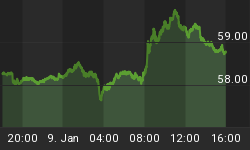The prices of gold and silver shares are derived from the price of their reference metals. The referral method has gone astray, akin to a renegade ETF.
Osiris Investment Partners L.P. in Boston, under the authorship of Principal and Managing Member Paul Stuka, wrote to clients on August 18, 2011. The XAU Gold Index was down 6% for the year-to-date, and the GDXJ Gold Stocks Index of smaller gold miners had fallen 10%. On that same mid-August date, gold - the real stuff that hardly anyone owns but of which everyone within the media's range is expected to express an opinion - had risen 26% in 2011.
The gap between gold and the diggers will close - when is hard to say. In which direction we will discover. The view here is that the stewardship of paper currencies, the medium in which gold, silver, and oil (crude, canola, and palm) are priced, has never been in worse hands. This is saying less than might be thought since it was not until 1971 that official money went untethered from impartial restraint (usually, gold). Alas, the world is slow to grasp central banks are peopled by political hacks (as Senator Harry Reid called then-Federal Reserve Chairman Alan Greenspan in 2005, but equally true of today's empty suit) so now is the time to make money.
Money is to be made by holding anti-dollars. Federal Reserve Chairman Ben S. Bernanke continues to decompose before our eyes, stating on September 8, 2011, that the United States is blessed with lower inflation than other countries and "Low inflation means that the buying power of the dollar, in terms of domestic goods and services, remains stable over time." It does not take a trial lawyer to see the inconsequentiality, inconsistency, or mendacity in that labored claim. Ben may be fishing turtles from the local creek, painting his barbarous equations on their backs, and selling them at the local five-and-dime (which would still be overvaluing his scholarship by at least a nickel), but shoppers at local farmer's markets are paying the price for purchasing with dollars.
Osiris Investment Partners went on to write: "[S]ince the early 1980s, when the XAU Index was first constructed, until the fall of 2008, this ratio remained in a range of .16 to .38, even during the depths of the gold bear market. [That is the ratio of the XAU Gold Stock Index divided by the price of an ounce of gold in U.S. dollars. - FJS] During the financial crisis of 2008, this ratio dropped briefly to .09. Since that time, it has traded up to .16, but it has never exceeded the former floor. As I write today the ratio is .114. In other words, the gold shares are currently the cheapest that they have ever been, excluding a one-month period in the fall of 2008. On a fundamental basis, gold stocks have historically traded at 10 times or more annual cash flow. We are presently seeing many companies priced at one to three times potential forward cash flow, if they can execute their plan. Clearly, not all of them will realize the potential. However, many will."
Of the cash flow, Erste Group, (Erste Bank, Vienna: "In Gold We Trust;" July, 2011; Ronald-Peter Stoferle), estimates the "aggregate free cash flow of the 16 companies in the Gold Bugs Index will amount to [$8.5 billion] this year and will increase to [$14 billion] by 2013." Erste Group continues: "The companies in the Gold Bugs Index currently command an estimated 2011 [price-to-earnings ratio of] 14x, which is expected to fall to 12x in 2012. This is extremely low in terms of its own history (average PE 2000-2010: 33x) and in relation to many other sectors." (The Gold Bugs Index consists of 16 mining companies that do not hedge their gold production. This is not necessarily true of the miners in the XAU Index.)
Potential investor seek the potential catalyst. What might that be?
First, the correlation among sectors in the S&P 500 has never been greater. ETFs and high-frequency trading rule the waves. Machines trade stocks in bulk, with little distinction among industries and companies. Such periods of over-zealous gimmickry and of intimidated investors are often good times to buy stocks that will later assert their superior characteristics.
Second, gold- and silver-mining shares are underowned in relation to one-stop-shopping ETFs. The miners know this. Shareholders have enlightened management: they need to pay out dividends to distinguish themselves as real companies. Recently, Newmont Mining stated it will increase its dividend by twenty cents per share for every $100 rise in the price of gold. Gold Resource Corporation has set a target of paying out one-third of its cash flow in dividends to shareholders.
Third, the argument of whether the world is inflating or deflating is tangential to the price of gold. Better expressing the "price of gold": how many units of paper currency (such as the dollar) does it cost to buy an ounce of gold? (We are returning, now, to the reference metal). Gold has performed better in deflations than inflations, but the cause and effect that this relationship addresses ("gold is an inflation hedge") may be misleading. Monetary, military, and political chaos have more often corresponded with deflationary than inflationary times. The real story is that gold is money but only speaks up when the credibility of states and their currencies deteriorate.
Fourth, the proportion of people who own gold and silver is small. (Particularly so in the United States, but that is not the point, here.) This is the greatest flaw of the "gold in a bubble" chorus. There has been no panic into gold, or, more likely for the Average Joe, into gold shares. At some point, the sight of Bernanke may be worth a quick $500-an-ounce trading profit. It should be, already.
Frederick Sheehan writes a blog at www.aucontrarian.com
















